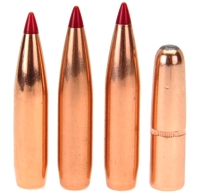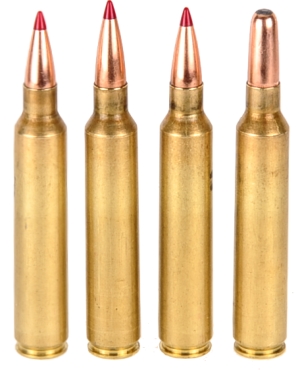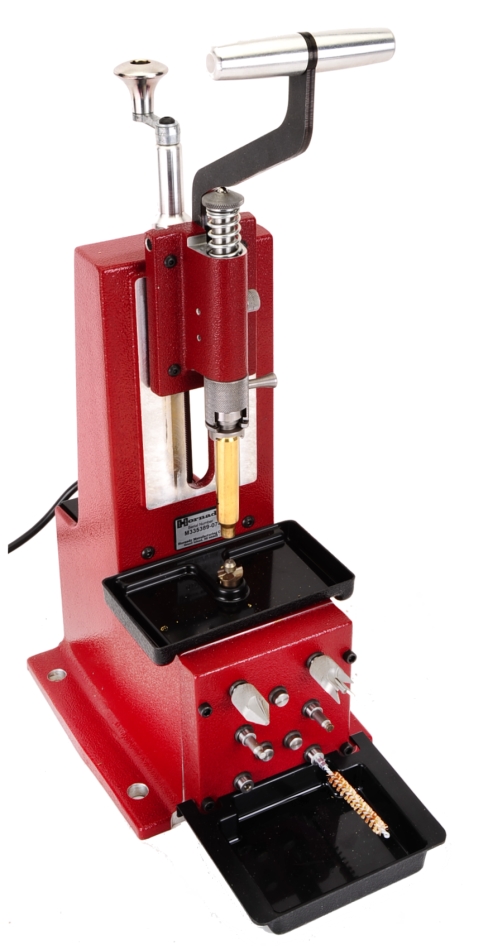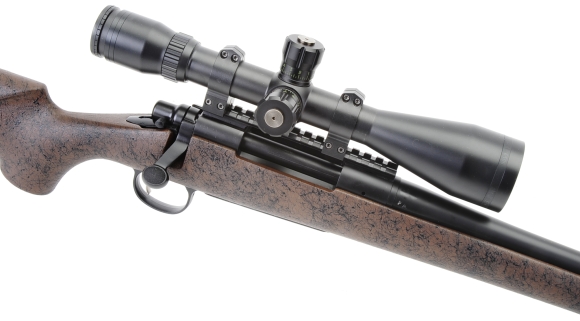01/01/2020

The higher velocity generated by a magnum version of any given caliber yields a number of benefits. Higher velocity, means reduced time in flight, which means a farther distance can be reached before significant effects of gravity are felt. With relative increases in velocity come kinetic energy increases at the square of the increase in velocity. Higher velocity also means a reduction in the time a bullet is exposed to winds crossing the path of a bullet and a subsequent reduction in drift.
The term “magnum”, in this context, is based upon measurable increases in velocity over a standard cartridge, not by cartridge nomenclature. The tables below illustrates magnum versus standard cartridge performance.
| Best Zero 30-06 ELD-X 200 Grain Bullet | |||||||
| Near-Zero – yds. | 24 | Mid Range – yds. | 129 | ||||
| Far-Zero – yds. | 229 | Max Ordinate – in. | +3.0 | ||||
| Point Blank – yds. | 244 | ||||||
| Extended Exterior Ballistics | ||||||||||||
| Yards | 0 | 50 | 100 | 150 | 200 | 250 | 300 | 350 | 400 | 450 | 500 | |
| Velocity – fps | 2650 | 2579 | 2509 | 2440 | 2372 | 2305 | 2240 | 2175 | 2112 | 2050 | 1989 | |
| Energy – ft.-lbs. | 3118 | 2953 | 2794 | 2643 | 2498 | 2360 | 2227 | 2101 | 1981 | 1866 | 1756 | |
| Momentum – lbs-sec | 76 | 74 | 72 | 70 | 68 | 66 | 64 | 62 | 60 | 59 | 57 | |
| Path – in. | -1.50 | 1.29 | 2.77 | 2.87 | 1.51 | -1.40 | -5.94 | -12.21 | -20.32 | -30.38 | -42.50 | |
| Drift – in. | 0.00 | 0.00 | 0.00 | 0.00 | 0.00 | 0.00 | 0.00 | 0.00 | 0.00 | 0.00 | 0.00 | |
| Time Of Flight – sec. | 0.00 | 0.06 | 0.12 | 0.18 | 0.24 | 0.30 | 0.37 | 0.44 | 0.51 | 0.58 | 0.65 | |
| Best Zero 300 RUM 200 Grain Bullet | |||||||
| Near-Zero – yds. | 29 | Mid Range – yds. | 152 | ||||
| Far-Zero – yds. | 271 | Max Ordinate – in. | +3.0 | ||||
| Point Blank – yds. | 288 | ||||||
| Extended Exterior Ballistics | ||||||||||||
| Yards | 0 | 50 | 100 | 150 | 200 | 250 | 300 | 350 | 400 | 450 | 500 | |
| Velocity – fps | 3150 | 3071 | 2993 | 2916 | 2841 | 2766 | 2693 | 2621 | 2550 | 2481 | 2412 | |
| Energy – ft.-lbs. | 4406 | 4187 | 3977 | 3776 | 3583 | 3398 | 3221 | 3051 | 2888 | 2733 | 2584 | |
| Momentum – lbs-sec | 90 | 88 | 86 | 83 | 81 | 79 | 77 | 75 | 73 | 71 | 69 | |
| Path – in. | -1.50 | 0.94 | 2.45 | 3.00 | 2.52 | 0.96 | -1.73 | -5.61 | -10.76 | -17.25 | -25.15 | |
| Drift – in. | 0.00 | 0.00 | 0.00 | 0.00 | 0.00 | 0.00 | 0.00 | 0.00 | 0.00 | 0.00 | 0.00 | |
| Time Of Flight – sec. | 0.00 | 0.05 | 0.10 | 0.15 | 0.20 | 0.25 | 0.31 | 0.37 | 0.42 | 0.48 | 0.54 | |
In the example above, the Remington Model 700 AWR in 300 Remington Ultra Magnum can more effectively handle a relatively heavy VLD bullet. It can take advantage of the aerodynamics of the bullet’s very low drag form and retain higher velocity over a longer distance than the 30-06 Springfield. Which takes us to the objective of Part II, heavy bullet, .30 caliber handloads for medium to large game and one for big and dangerous game.
 Left to right: Hornady 200, 212 and 220 ELD-X bullets and 220 Grain Round Nose Interlock.
Left to right: Hornady 200, 212 and 220 ELD-X bullets and 220 Grain Round Nose Interlock.
The three Hornady ELD-X bullets were selected for handloads for use with medium to large game. The Hornady round nose Interlock was selected for dangerous game applications. The application recommendation is from the manufacturer, a source with generations of design experience and enhanced test methods, and with a great deal of empirical data to guide product development and application validation.
The three ELD-X bullets have a recommended muzzle velocity range of 2,000 fps to 3,100 fps. The Round Nose interlock as a recommended muzzle velocity of 1,600 fps to 3,100 fps. For effective expansion, 50% to 100%, the ELD-X bullets have a recommended impact velocity between 1,600 fps and 2,600 fps. The Interlock recommended impact velocity is 1,800 to 2,600 fps.
While the 220 Grain ELD-X and 220 Grain Round Nose Interlock have similar or at least overlapping ranges for muzzle velocity and impact velocity, the effective range within impact velocity is quite different due to the round nose lower BC and jacket toughness. Illustration:
| Best Zero 300 RUM 220 Grain ELD-X Bullet | |||||||
| Near-Zero – yds. | 27 | Mid Range – yds. | 143 | ||||
| Far-Zero – yds. | 255 | Max Ordinate – in. | +3.0 | ||||
| Point Blank – yds. | 272 | ||||||
| Extended Exterior Ballistics | ||||||||||||
| Yards | 0 | 50 | 100 | 150 | 200 | 250 | 300 | 350 | 400 | 450 | 500 | |
| Velocity – fps | 2950 | 2877 | 2805 | 2734 | 2664 | 2595 | 2527 | 2460 | 2395 | 2330 | 2266 | |
| Energy – ft.-lbs. | 4250 | 4042 | 3842 | 3650 | 3465 | 3288 | 3119 | 2956 | 2801 | 2652 | 2509 | |
| Momentum – lbs-sec | 93 | 90 | 88 | 86 | 84 | 82 | 79 | 77 | 75 | 73 | 71 | |
| Path – in. | -1.50 | 1.06 | 2.58 | 2.99 | 2.23 | 0.25 | -3.01 | -7.64 | -13.71 | -21.29 | -30.47 | |
| Drift – in. | 0.00 | 0.00 | 0.00 | 0.00 | 0.00 | 0.00 | 0.00 | 0.00 | 0.00 | 0.00 | 0.00 | |
| Time Of Flight – sec. | 0.00 | 0.05 | 0.10 | 0.16 | 0.21 | 0.27 | 0.33 | 0.39 | 0.45 | 0.52 | 0.58 | |
| Best Zero 300 RUM 220 Grain RN Interlock | |||||||
| Near-Zero – yds. | 26 | Mid Range – yds. | 136 | ||||
| Far-Zero – yds. | 237 | Max Ordinate – in. | +3.0 | ||||
| Point Blank – yds. | 252 | ||||||
| Extended Exterior Ballistics | ||||||||||||
| Yards | 0 | 50 | 100 | 150 | 200 | 250 | 300 | 350 | 400 | 450 | 500 | |
| Velocity – fps | 2950 | 2795 | 2645 | 2501 | 2361 | 2225 | 2095 | 1969 | 1848 | 1732 | 1620 | |
| Energy – ft.-lbs. | 4250 | 3816 | 3418 | 3054 | 2722 | 2419 | 2144 | 1894 | 1668 | 1465 | 1283 | |
| Momentum – lbs-sec | 93 | 88 | 83 | 79 | 74 | 70 | 66 | 62 | 58 | 54 | 51 | |
| Path – in. | -1.50 | 1.13 | 2.66 | 2.94 | 1.82 | -0.85 | -5.28 | -11.69 | -20.35 | -31.55 | -45.66 | |
| Drift – in. | 0.00 | 0.00 | 0.00 | 0.00 | 0.00 | 0.00 | 0.00 | 0.00 | 0.00 | 0.00 | 0.00 | |
| Time Of Flight – sec. | 0.00 | 0.05 | 0.11 | 0.17 | 0.23 | 0.29 | 0.36 | 0.44 | 0.51 | 0.60 | 0.69 | |
Essentially, the ELD-X can deliver at 500 yards what the Round Nose Interlock can deliver at 250 yards. So why not just use the ELD-X bullet? Because it is not constructed for use on dangerous game, but rather medium and large, thin skinned game. The Interlock, with round nose and tough jacket, is in its impact velocity range at just 100 yards where the ELD-X hits at 200 yards. The ELD-X provides power at a distance where the Interlock range provides power close in where dangerous game would typically be taken.
In this case, all of the bullets are Hornady, but the same applies to all brands and types of bullets. All bullet manufacturers provide recommended muzzle velocity and impact velocity for each hunting bullet. Sometimes the information is published, sometimes a call or email request for info is needed, but it is necessary for bullet selection. In other cases, the changing ballistic coefficient is given at steps in velocity for competition shooters, but that application is beyond the subject of this article.
Handload data
Warning: Bullet selections are specific, and loads are not valid with substitutions of different bullets of the same weight. Variations in bullet length will alter net case capacity, pressure and velocity. Primer selection is specific and primer types are not interchangeable. These are maximum loads in my firearms and may be excessive in others. All loads should be reduced by 5% as a starting point for development where cartridges have greater than 40 grains in capacity and 10% for cartridges with less than 40 grain capacity following safe handloading practices as represented in established mainstream reloading manuals. Presentation of these loads does not constitute a solicitation for their use, nor a recommendation.

| 300 Remington Ultra Magnum – MAP 65KPSI |
|
| Firearm | Remington Model 700 AWR |
| Barrel Length | 26.00″ |
| Max Case Length | 2.850″ +0.000″/-0.020″ |
| Min – Max COL | 3.450″ – 3.600″ |
| Primer | CCI 250 (LRM) |
| Bullet Diameter | 0.3090″ +0.000″/-0.0030″ |
| Reloading Dies | Hornady |
| Bullet Type | Bullet Weight Grains |
Net H2O Grains Capacity |
COL” | Powder Type | Powder Charge Grains |
Muzzle Velocity fps |
Muzzle Energy ft/lbs |
100 Yard 5 Shot Group” |
| Hornady ELD-X | 200 | 98.7 | 3.595 | Re 22 | 86.0 | 3087 | 4233 | 0.9 |
| Hornady ELD-X | 200 | 98.7 | 3.595 | Retumbo | 94.0 | 3151 | 4410 | 0.4 |
| Hornady ELD-X | 200 | 98.7 | 3.595 | RS Magnum | 91.0 | 3134 | 4363 | 0.6 |
| Hornady ELD-X | 212 | 97.4 | 3.600 | Re 33 | 97.0 | 3084 | 4478 | 0.8 |
| Hornady ELD-X | 212 | 97.4 | 3.600 | Retumbo | 92.0 | 3067 | 4429 | 1.0 |
| Hornady ELD-X | 212 | 97.4 | 3.600 | Norma 217 | 92.0 | 3073 | 4446 | 0.7 |
| Hornady ELD-X | 220 | 96.1 | 3.600 | Re 33 | 96.0 | 3079 | 4632 | 0.8 |
| Hornady ELD-X | 220 | 96.1 | 3.600 | Retumbo | 91.0 | 3032 | 4492 | 0.7 |
| Hornady ELD-X | 220 | 96.1 | 3.600 | Norma 217 | 91.0 | 3019 | 4454 | 0.5 |
| Hornady Interlock RN | 220 | 102.0 | 3.575 | Re 33 | 100.0 | 3024 | 4468 | 1.0 |
| Hornady Interlock RN | 220 | 102.0 | 3.575 | Retumbo | 93.0 | 3002 | 4404 | 1.1 |
| Hornady Interlock RN | 220 | 102.0 | 3.575 | Norma 217 | 94.0 | 3036 | 4504 | 0.9 |
Anything Interesting to report? Glad you asked.
From a handloading standpoint, the 300 Remington Ultra Magnum is very straight forward. Regardless the powder type selected, there were no compressed loads. Remington brass held up well, all were full length resized, brass was prepped the same as any handloads with good quality and process control.

Hornady bullets were consistent and size and weight. velocity spread when recording chronograph readings. All cases were full length resized, dies used were Hornady, all cases were prepped the same. I did check each configuration with an overall cartridge length gauge, but stayed with manufacturer recommendation with the exception of the 212 grain. My manual indicates 3.900″ which I believe is a typo. There was room to seat bullets out further than spec, but I saw little to be gained.
A very long time ago, chambers were cut with a generous throat size. Additionally, heavily used rifles with barrel steel of the day tended to rapidly erode. Compensation or corrective action was to seat bullets out close to, or even riding, the rifling leade so assure a controlled path to the bore to get more life out of a barrel. It was less costly than setting back a barrel and rechambering or rebarreling. I do not shoot heavy magnum rifles with high frequency, just enough to retain proficiency and to qualify best handloads. I have never been able to consistently demonstrate measurable gains in accuracy by seating bullets just shy of the rifle’s leade, so I stick with recommended cartridge overall length. But enough about me…
Seeing red
OK. I may have gone a little Hornady wacky on this project. I’m old, very, very old. Almost geologically so. When my 25 year old RCBS power trimmer belched smoke and sighed its last breath, I decided I would invest in some stout equipment that I could will to my grandkids… maybe great grandkids, and picked up a Hornady Lock-N-Load® Power Case Prep Center.
After a few hours of trimming, reaming, primer pocket cleaning, and inside neck cleaning, the process became a bit of handloading decadence. Trim accuracy was excellent, case mouth were burr free and perpendicular to bore axis, primer pockets were truly clean, and I learned how to clean inside case necks without bending the brush. Neato.

Sure, I miss the way my old RCBS trimmer would jump adjustment and trim 338-378 Weatherby brass down to 38 Special length. I miss buying a trimmer shell plate to match up with each shell holder. Still, just watching those accessory tools go around and around and being able to adjust trim length in 0.001″ increments got me over the entertainment value of the RCBS unit. The Hornady unit also got a number of individual tools and fixtures off of my bench and consolidated tool space.
The chassis is stout, but made of aluminum. Way more than enough weight to clamp the base rather than 1/2″ bolt it down, even if I violated two or three dozen OSHA regulations. I did not bolt it down because it was moved about based on tasks assigned, however, I am sure it will find a permanent place eventually. It has been on the market for going on eight years, so it is a mature product, but if I get a break in the schedule I will cover the unit on more detail.
Back to the Remington Model 700 American Wilderness Rifle
I really like this rifle. It is big, bold and powerful. At approximately 8 1/4 lbs with scope, recoil was manageable. I am not recoil sensitive, but I am also not a recoil junkie. Shooting from the bench a couple of boxes of ammo does not feel like a day of shooting a 223 Rem varmint rifle, but it also isn’t a day of shooting a 378 Weatherby. The stock fit, length of pull, sweep of the pistol grip and underside of the forearm are excellent for holding a target and support. Nice recoil pad that provides good service.

The subject rifle was accurate, particularly when collecting data from targets at 31°F and trekking through snow. Most of the powder selected was temperature insensitive. The scope stayed put, the rifle’s finish stayed on and it looked as good putting it away as it did coming out of the box. The barrel length would play long and the the 300 Remington Ultra Magnum cartridge would be a bit much for Maine. Even with a moose lottery, this is 20″ barrel, 308 Winchester country or less. If I were hunting an area where there is a real potential for 200 yard shots, or game that is big and dangerous, the combination would be just about right. It is a very nice firearm, built in American facilities with an American work force. Yes, that does matter to me.

Email Notification